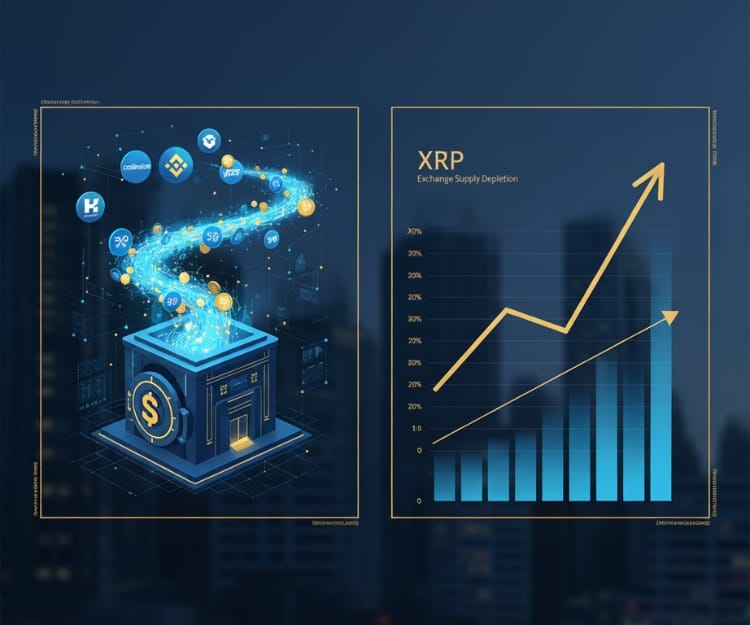Could Institutional Accumulation Trigger the Shane Ellis XRP Theory?
Evernorth's $1B+ SPAC merger to build the world's largest XRP treasury reignites debate around the Shane Ellis Theory as billions of XRP vanish from exchanges. Are we witnessing the supply shock conditions that could trigger dramatic price appreciation? Analysis of theory vs. reality.

New $1B+ SPAC merger to create world's largest XRP treasury as exchange supply vanishes
Evernorth, backed by Ripple, announced today its merger with SPAC Armada Acquisition Corp II to go public on Nasdaq under the ticker "XRPN," raising over $1 billion in gross proceeds to build what would become the world's largest institutional XRP treasury. The move has reignited discussion around the Shane Ellis Theory—a controversial but increasingly discussed framework suggesting XRP could experience dramatic price increases through coordinated institutional liquidity mechanisms and supply shocks.
The timing is striking. As Evernorth prepares to deploy capital specifically for open-market XRP purchases, billions of XRP tokens have already been disappearing from major exchanges over recent months. The convergence of these developments has market observers asking whether the conditions described in the Shane Ellis Theory are beginning to materialize in real-time.
Understanding the Shane Ellis Theory
The Shane Ellis Theory proposes that XRP could experience rapid, exponential price appreciation through a specific mechanism involving exchanges partnered with Ripple acting as "preferred liquidity providers." According to this framework, these exchanges would coordinate to create extremely tight spreads, synchronize pricing globally to eliminate arbitrage opportunities, and maintain deep liquidity through pre-funded XRP reserves for institutional transactions.
The theory's most controversial element suggests that relatively small amounts of coordinated capital could create significant buy walls when exchange liquidity becomes thin, potentially driving dramatic price movements. Ellis theorized that as billions of XRP move from public exchanges into institutional custody, the resulting supply shock could trigger the conditions for rapid price appreciation—potentially to levels like $500 per token that seem implausible under normal market mechanics.
Critics have dismissed the theory as speculative, noting it would require unprecedented coordination between exchanges and institutions. However, recent developments are causing some analysts to reconsider whether key elements of this framework are taking shape.
The Evernorth Catalyst: Institutional Infrastructure Arrives
Today's Evernorth announcement represents a watershed moment for institutional XRP accumulation. The SPAC merger brings together an extraordinary coalition of backers: SBI Holdings is contributing $200 million, alongside investments from Ripple, Pantera Capital, Kraken, and Ripple co-founder Chris Larsen, who is personally contributing 50 million XRP tokens.
According to the official announcement, net proceeds will primarily fund open-market purchases of XRP, with plans to participate in institutional lending, liquidity provisioning, and decentralized finance (DeFi) yield opportunities. This isn't speculative retail accumulation—it's regulated, public-market infrastructure designed specifically for large-scale XRP acquisition and management.
The institutional nature of this vehicle matters significantly. Unlike retail investors or even crypto-native funds, a publicly traded company on Nasdaq operates under regulatory oversight and fiduciary duties that typically favor long-term holding strategies rather than short-term trading. This creates exactly the type of "sticky" institutional custody that removes circulating supply from exchanges for extended periods.
Exchange Supply Vanishing: The Ellis Theory Playing Out?
Recent blockchain data reveals a striking trend: billions of XRP tokens have been moving off major exchanges. According to analysis tracking exchange reserves, several major platforms have seen substantial outflows as XRP moves into private wallets and institutional custody solutions.
This pattern aligns directly with the supply shock mechanism described in the Ellis Theory. As available supply on exchanges decreases, the theory suggests that price discovery becomes more sensitive to buying pressure. With fewer tokens available for immediate purchase on exchanges, institutional demand—like the billion-dollar accumulation Evernorth is planning—could have outsized impact on price formation.
The connection isn't merely coincidental. The Ellis Theory specifically anticipated that institutional players would build infrastructure to accumulate XRP at scale before the supply constraints became widely recognized. Evernorth's public announcement, backed by some of crypto's most significant institutional players, represents exactly this type of coordinated infrastructure development.
The Jake Claver Connection: Convergence of Theories
While Shane Ellis focused on exchange mechanics and liquidity coordination, crypto analyst Jake Claver has developed a complementary framework examining XRP's potential role in institutional cross-border payment systems. Claver's analysis emphasizes how increasing adoption by financial institutions for international settlements could drive sustained demand while simultaneously reducing circulating supply as institutions hold XRP for operational liquidity needs.
The overlap between these frameworks is significant. Both theorists identify institutional custody and operational demand as key catalysts. Both anticipate supply leaving public exchanges. And both suggest that XRP's price discovery mechanism could fundamentally change once institutional infrastructure reaches critical mass.
Claver has specifically noted that as institutions adopt XRP for payment corridors, they typically hold reserves proportional to transaction volumes—creating natural accumulation pressure that compounds over time. When this institutional accumulation (Claver's focus) combines with coordinated liquidity mechanisms and exchange supply shocks (Ellis's focus), the two theories create a reinforcing framework.
The Evernorth announcement sits at the intersection of both theories. It represents institutional infrastructure (validating Claver's framework) specifically designed to accumulate and remove XRP from circulation (validating Ellis's supply shock mechanism). Whether either theory's price predictions materialize remains speculative, but the institutional developments they anticipated are now documented and public.
XRP and Ripple: Implications for the Ecosystem
For XRP specifically, institutional treasury vehicles like Evernorth could fundamentally alter market dynamics. Unlike algorithmic stablecoins or proof-of-work assets, XRP's predetermined supply of 100 billion tokens means that institutional accumulation directly reduces the float available for price discovery on exchanges.
Ripple's involvement as both a backer of Evernorth and the primary company driving institutional XRP adoption creates a strategic alignment. As Ripple continues expanding its On-Demand Liquidity (ODL) product with financial institutions globally, the operational demand for XRP increases—while simultaneously, vehicles like Evernorth are building capacity to absorb supply from public markets.
The regulatory landscape also matters significantly. Following Ripple's partial legal victory against the SEC, institutional confidence in XRP has visibly increased. The willingness of major players like SBI Holdings and Pantera Capital to publicly back a $1 billion XRP treasury suggests institutional views on regulatory risk have shifted considerably.
However, questions remain. How will the SEC's potential appeal affect institutional appetite? Will other institutions follow Evernorth's model? And critically for the Ellis Theory—are exchanges actually coordinating liquidity, or is the supply decrease simply organic institutional accumulation?
Market Implications and Price Potential
The Ellis Theory's price targets—often cited as $500 or higher—remain highly speculative and should not be treated as predictions or investment advice. However, the underlying mechanism of supply shocks affecting price discovery is well-established in traditional markets. When float decreases substantially while demand increases or remains constant, prices can move dramatically.
Bitcoin's supply shocks following halving events provide a relevant comparison, though XRP's mechanism would differ significantly. Unlike Bitcoin's algorithmic supply reduction, XRP's potential supply shock would result from voluntary institutional custody—a factor that's reversible if institutions choose to sell.
The broader crypto market could also be affected. If institutional XRP accumulation continues accelerating, it may signal a broader shift toward institutional custody of digital assets, potentially affecting how exchanges manage liquidity for other tokens. The precedent of a publicly traded vehicle dedicated to single-token accumulation could inspire similar structures for other major cryptocurrencies.
Trading volumes and liquidity depth on major exchanges will be critical metrics to watch. If the Ellis Theory's coordination mechanism exists, it should manifest as unusually tight spreads and synchronized pricing across exchanges as institutional players establish liquidity operations.
Regulatory Considerations and Compliance
Evernorth's decision to go public via SPAC merger rather than remain private is significant from a regulatory perspective. As a Nasdaq-listed company, Evernorth will face disclosure requirements, auditing standards, and regulatory oversight that provide transparency into its XRP holdings and operations.
This regulatory framework could actually validate aspects of the Ellis Theory by creating legitimate, compliant infrastructure for coordinated institutional liquidity provision. Rather than shadowy coordination, institutional players can now participate in XRP markets through regulated vehicles with transparent reporting.
The SEC's ongoing evolution of crypto regulation will influence how these institutional vehicles operate. Clear regulatory frameworks could accelerate institutional adoption and accumulation, potentially intensifying the supply dynamics both Ellis and Claver identified.
However, regulatory uncertainty remains a risk factor. Changes in how crypto assets are classified, potential restrictions on institutional custody, or shifts in international regulatory approaches could affect the thesis underlying both theories.
Critical Perspective: Speculation vs. Reality
It's essential to distinguish between documented developments and theoretical speculation. What we can verify: Evernorth is raising over $1 billion specifically for XRP accumulation, backed by major institutions. Exchange reserves of XRP have measurably decreased. Institutional infrastructure for XRP custody and liquidity is expanding.
What remains speculative: Whether exchanges are coordinating liquidity as Ellis theorized. Whether supply shocks will translate to the dramatic price increases predicted. Whether institutional accumulation will continue at current rates or accelerate further.
Crypto analyst Marcus Aurelius, who has studied both theories, cautions that "while institutional accumulation is real and measurable, the price impact predictions assume continued accumulation, absence of institutional selling, and market mechanics that may not manifest as theorized." He notes that institutional players could just as easily provide liquidity to markets rather than remove it, depending on their business models and strategies.
The Ellis Theory also assumes a level of exchange coordination that, while theoretically possible through market-making agreements and liquidity partnerships, has not been publicly documented or confirmed by exchanges themselves.
Conclusion: Theory Meets Reality
The Evernorth announcement and recent exchange supply trends suggest that key elements of the Shane Ellis Theory—particularly around institutional accumulation removing supply from circulation—are materializing in documented, verifiable ways. Whether this ultimately produces the dramatic price effects Ellis predicted remains to be seen, but the infrastructure and supply dynamics he identified are no longer merely theoretical.
The convergence with Jake Claver's institutional adoption framework creates a compelling narrative: as institutions build operational and investment infrastructure around XRP, supply naturally migrates from public exchanges to institutional custody, potentially altering price discovery mechanisms in ways that favor rapid appreciation during periods of buying pressure.
For XRP holders and Ripple's ecosystem, these developments represent a significant maturation of institutional infrastructure. For skeptics, they provide the first major test of whether theories about coordinated institutional accumulation can actually affect crypto market dynamics at scale.
The key question is no longer whether institutions are accumulating XRP—Evernorth's $1 billion commitment confirms they are. The question is whether this accumulation, combined with exchange supply dynamics, will produce the supply shock conditions that both Ellis and Claver identified as catalysts for significant price appreciation.
Over the coming months, exchange reserve data, Evernorth's acquisition pace, and XRP price action will provide empirical evidence for whether these theories hold predictive value or represent compelling narratives that ultimately don't materialize as anticipated.
Sources
- Evernorth SPAC Merger Announcement
- Shane Ellis Theory Detailed Explanation
- Analysis of XRP Exchange Outflows
- Ripple Official Website - XRP Information
- Ripple On-Demand Liquidity Overview
- SEC vs. Ripple Case Information
- Jake Claver XRP Analysis Thread
- SBI Holdings Corporate Information
DISCLAIMER: This newsletter is for informational purposes only and does not constitute investment advice, advertising, or a recommendation to buy, sell, or hold any securities. This content is not sponsored by or affiliated with any of the mentioned entities. Investments in cryptocurrencies or other financial assets carry significant risks, including the potential for total loss, extreme volatility, and regulatory uncertainty. Past performance is not indicative of future results. Always consult a qualified financial professional and conduct thorough research before making any investment decisions.



